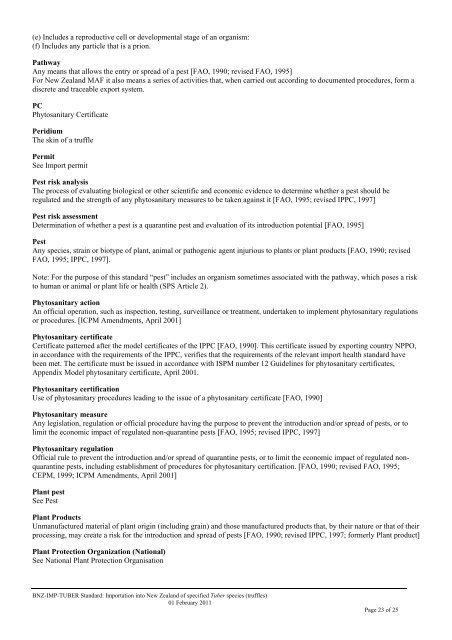BIOSECURITY NEW ZEALAND STANDARD BNZ-IMP-TUBER ...
BIOSECURITY NEW ZEALAND STANDARD BNZ-IMP-TUBER ...
BIOSECURITY NEW ZEALAND STANDARD BNZ-IMP-TUBER ...
You also want an ePaper? Increase the reach of your titles
YUMPU automatically turns print PDFs into web optimized ePapers that Google loves.
(e) Includes a reproductive cell or developmental stage of an organism:<br />
(f) Includes any particle that is a prion.<br />
Pathway<br />
Any means that allows the entry or spread of a pest [FAO, 1990; revised FAO, 1995]<br />
For New Zealand MAF it also means a series of activities that, when carried out according to documented procedures, form a<br />
discrete and traceable export system.<br />
PC<br />
Phytosanitary Certificate<br />
Peridium<br />
The skin of a truffle<br />
Permit<br />
See Import permit<br />
Pest risk analysis<br />
The process of evaluating biological or other scientific and economic evidence to determine whether a pest should be<br />
regulated and the strength of any phytosanitary measures to be taken against it [FAO, 1995; revised IPPC, 1997]<br />
Pest risk assessment<br />
Determination of whether a pest is a quarantine pest and evaluation of its introduction potential [FAO, 1995]<br />
Pest<br />
Any species, strain or biotype of plant, animal or pathogenic agent injurious to plants or plant products [FAO, 1990; revised<br />
FAO, 1995; IPPC, 1997].<br />
Note: For the purpose of this standard “pest” includes an organism sometimes associated with the pathway, which poses a risk<br />
to human or animal or plant life or health (SPS Article 2).<br />
Phytosanitary action<br />
An official operation, such as inspection, testing, surveillance or treatment, undertaken to implement phytosanitary regulations<br />
or procedures. [ICPM Amendments, April 2001]<br />
Phytosanitary certificate<br />
Certificate patterned after the model certificates of the IPPC [FAO, 1990]. This certificate issued by exporting country NPPO,<br />
in accordance with the requirements of the IPPC, verifies that the requirements of the relevant import health standard have<br />
been met. The certificate must be issued in accordance with ISPM number 12 Guidelines for phytosanitary certificates,<br />
Appendix Model phytosanitary certificate, April 2001.<br />
Phytosanitary certification<br />
Use of phytosanitary procedures leading to the issue of a phytosanitary certificate [FAO, 1990]<br />
Phytosanitary measure<br />
Any legislation, regulation or official procedure having the purpose to prevent the introduction and/or spread of pests, or to<br />
limit the economic impact of regulated non-quarantine pests [FAO, 1995; revised IPPC, 1997]<br />
Phytosanitary regulation<br />
Official rule to prevent the introduction and/or spread of quarantine pests, or to limit the economic impact of regulated nonquarantine<br />
pests, including establishment of procedures for phytosanitary certification. [FAO, 1990; revised FAO, 1995;<br />
CEPM, 1999; ICPM Amendments, April 2001]<br />
Plant pest<br />
See Pest<br />
Plant Products<br />
Unmanufactured material of plant origin (including grain) and those manufactured products that, by their nature or that of their<br />
processing, may create a risk for the introduction and spread of pests [FAO, 1990; revised IPPC, 1997; formerly Plant product]<br />
Plant Protection Organization (National)<br />
See National Plant Protection Organisation<br />
<strong>BNZ</strong>-<strong>IMP</strong>-<strong>TUBER</strong> Standard: Importation into New Zealand of specified Tuber species (truffles)<br />
01 February 2011<br />
Page 23 of 25
















